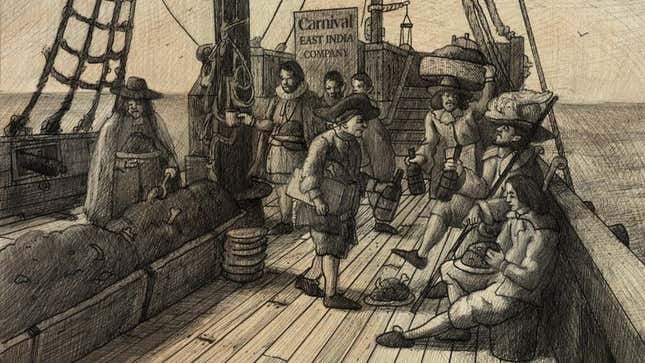
LONDON—Working from recently discovered ships’ logs and archaeological findings, a team of historians announced Monday they had pieced together a detailed account of the Carnival East India Company’s maiden cruise—the very first seafaring journey to the Far East dedicated solely to the enjoyment and entertainment of its passengers.
According to records, the 175-foot, 1,400-ton sailing ship—christened the H.M.S. Sunshine—embarked from London in February 1605 on the first-ever “Expedition under-tak’n on behalfe of Plea-sure,” as it is referred to in writings from the time, with an itinerary that included stops in Ceylon, Malay, Nieuw-Guinea, and various tropical locales in the South China Sea.
“The Carnival East India Company was the first joint-stock cruise line to offer recreational voyages beyond the Cape of Good Hope and was widely popular among 17th-century English citizens for its all-inclusive packages that covered the costs of passengers’ lodging, meals, and leech treatments,” said Dr. Henry Carter, a leading maritime historian at Cambridge University who headed up the six-year investigation into the voyage after locating the company’s long-forgotten Royal Charter for the “Cultivation and Discoverance of all Manner of MARI-TIME LEISURE that GOD may deem Fit & Suitable” in the university’s archives. “The 110-week excursion offered people who could afford to let their fields lie fallow for two years a way to reduce the stress caused by a lifetime of toil and plague.”
“Primary sources suggest that the one-third of passengers who were not taken captive by mercenaries or impressed into naval service had the time of their lives,” he added, “at least until they succumbed to dysentery.”
Carter noted that newly unearthed sketches of the ship indicate that the H.M.S. Sunshine was outfitted with a variety of unique features, including long communal troughs of hardtack, gruel, and grog, which were available belowdecks at any time of day or night, and a large recreational wooden slide moistened with water pumped from the bilge.
Additionally, broadsheet advertisements leading up to the cruise enticed passengers with the opportunity to “gorge upon the vaste Allot-ment of FOODE ’til one’s Appetite be SLAKED, and thereupon LIE-ABOUT above-decks and becomme redden’d unto the Duyvil Him-self in the boyling SUN.”
Beyond its promise of general leisure, the ship is known to have offered several scheduled entertainment options, the most popular of which was the nightly opportunity to have clergymen flagellate any passengers who believed they deserved punishment for their idleness, frivolity, or other mortal sins. In addition, it is believed that voyagers could disembark at various ports of call to gawk at “savages” and buy small satchels of spices, indigo dyes, jade, or opium.
“Several surviving written accounts of the voyage mention that by far the most popular diversion on the H.M.S. Sunshine was a kindly Italian magician named Giuseppe who performed a simple cup-and-ball routine and was adored by the children on the ship,” Carter said. “In fact, many aboard expressed regret when, after roughly 48 hours at sea, Giuseppe was burned alive on the main deck by a mob of passengers who had charged him with the crime of witchcraft.”
Much of what is known about the ship’s onboard amenities reportedly comes from a journal kept by Myhil Osborne, a member of England’s landed gentry who, at 41 years of age, was one of the ship’s few elderly passengers. In his writings, he raved about “lodgings of gen’rous measure” in which only 20 to 30 people were bunked in an 8-by-10-foot cabin, as opposed to the roughly 80 passengers housed in identically sized quarters in steerage.
“I am a full Fort-night into my Sojourne, but only thryce yet have I beene poisen’d unto vomitous Bile and runny-ing Feculence by somme be-fouled Pottage or badly salt’d Meate,” Osborne wrote in praise of his experience aboard the H.M.S. Sunshine’s maiden voyage. “Verily, not Two-Score Deathes have I witness’d of late, and those mere Cases of Scurvy, Drowning, Dæmon possession, Grippe, Mariner’s Palsy, or Childe-birth.”
Subsequent Carnival East India cruises did not fare as well, according to researchers. Pirate attacks were reportedly common, as were wrecks in which all hands were lost, often when a ship attempted to anchor off dangerous reef-ringed coastlines in search of tax-free gold.
“At one point, the Carnival East India Company actually laid claim to an entire 2,400-acre island intended as a private retreat for its passengers,” said Carter, referring to a remote desert isle in a then-uncharted region off the coast of Siam. “However, years of cannibal attacks eventually forced the company to abandon it.”
The wreck of the H.M.S. Sunshine now lies somewhere just east of the Seychelles, where historical accounts confirm it sank in 1613 after the ship’s crew mutinied and purposely capsized the vessel to avoid hearing another set by the ship’s dueling harpsichord players.